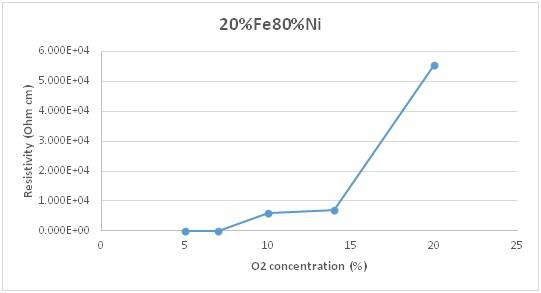Ricky Scott's project page
 |
Electrical four point probe measurements on Ni-Fe-O thin films sputtered at different oxygen flow rates. |
|
Ricky Scott
Texas State University at San Marcos, Department of Physics, RFM 3228, 601 University Drive, San Marcos, TX78666.
|
The purpose of this research is to find the resistivity of NiFe-oxide thin films which can be used as a dielectric in resistive Random Access Memory (ReRAM). ReRAM a non-volatile memory technology that is currently investigated to replace Flash memory beyond the 14 nm technology node. Although there is nothing wrong with Flash memory, it’s just that companies believe it is on its last generation of advancement. Higher information densities mean less electrons per bit, which makes it more and more challenging for future technology nodes to retain the information in Flash memory over a period of 10 years. It is sometimes stated that Flash memory will soon run out of electrons.
Two different series of NiFe-oxide films were investigated. The first set consisted of 10 percent Iron and 90 percent Nickel and the second series consisted of 20 percent Iron and 80 percent Nickel. The films were made using reactive RF sputtering using a mix of oxygen and argon as a sputter gas. The oxygen flow rate was varied for the different samples (5%, 7%, 10%, 14%, and 20%). The objective of my research was to determine the resistivity of the films. This included the measurement of the resistance of the samples using linear four point probe and the determination of the film thickness of the samples using an ellipsometer. The latter was done together with Yubo Cui a graduate student at Texas State. ReRAM is based on the reversible switching between a low resistance and a high resistance state of the dielectric material via soft-breakdown. The mechanism of soft break-down is not completely understood but involves the creation of a conductive path between both electrodes. The mechanism is influenced by the concentration of oxygen vacancies (oxide bond locations where the oxygen has been removed) and or metal or oxygen interstitials. Those charged defects can drift under the application of an electric field. Pure crystal structures are insulators or semiconductors, but materials with oxygen vacancies or oxygen interstitials can be partly metallic (low resistance state). ReRAM is appealing because of its small cell structure and low power consumption. Its application can make devices smaller and use less power, meaning longer battery life. The main conclusion of my research was that the resistivity depends strongly on the oxygen flow during the sputtering process. Higher oxygen flow rates results in higher resistivities.The resistivity is very inhomogeneous for flow rates around 10%. Additional testing is required to get a better idea on how oxygen flow rate influences the resistivity of Ni-Fe-oxide thin films. Reports/Publications/Presentations: [1] Ricky Scott, Resistivity of NiFe-Oxide Thin films as a function of oxygen flow, technical report May 2015. |
|

